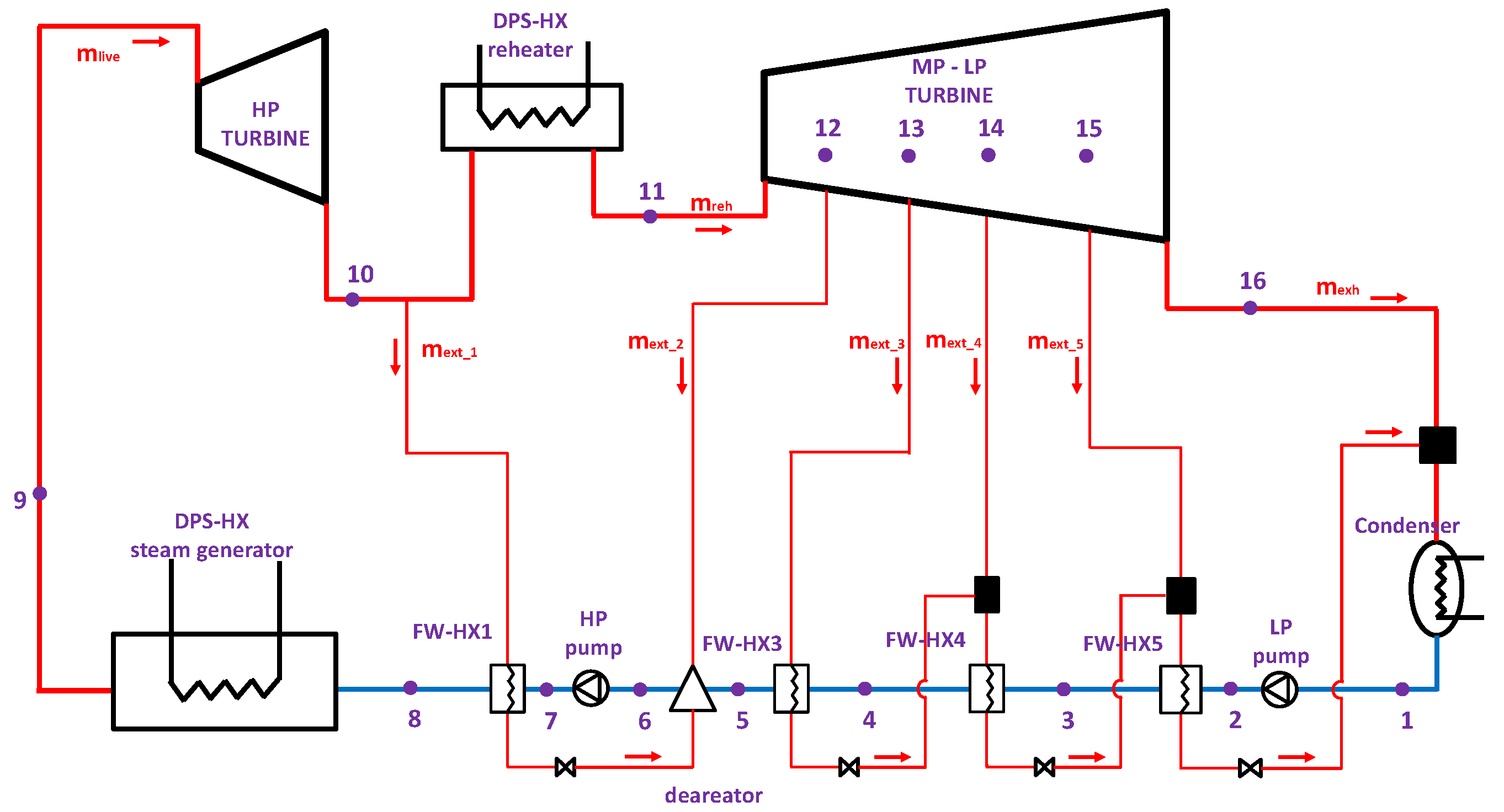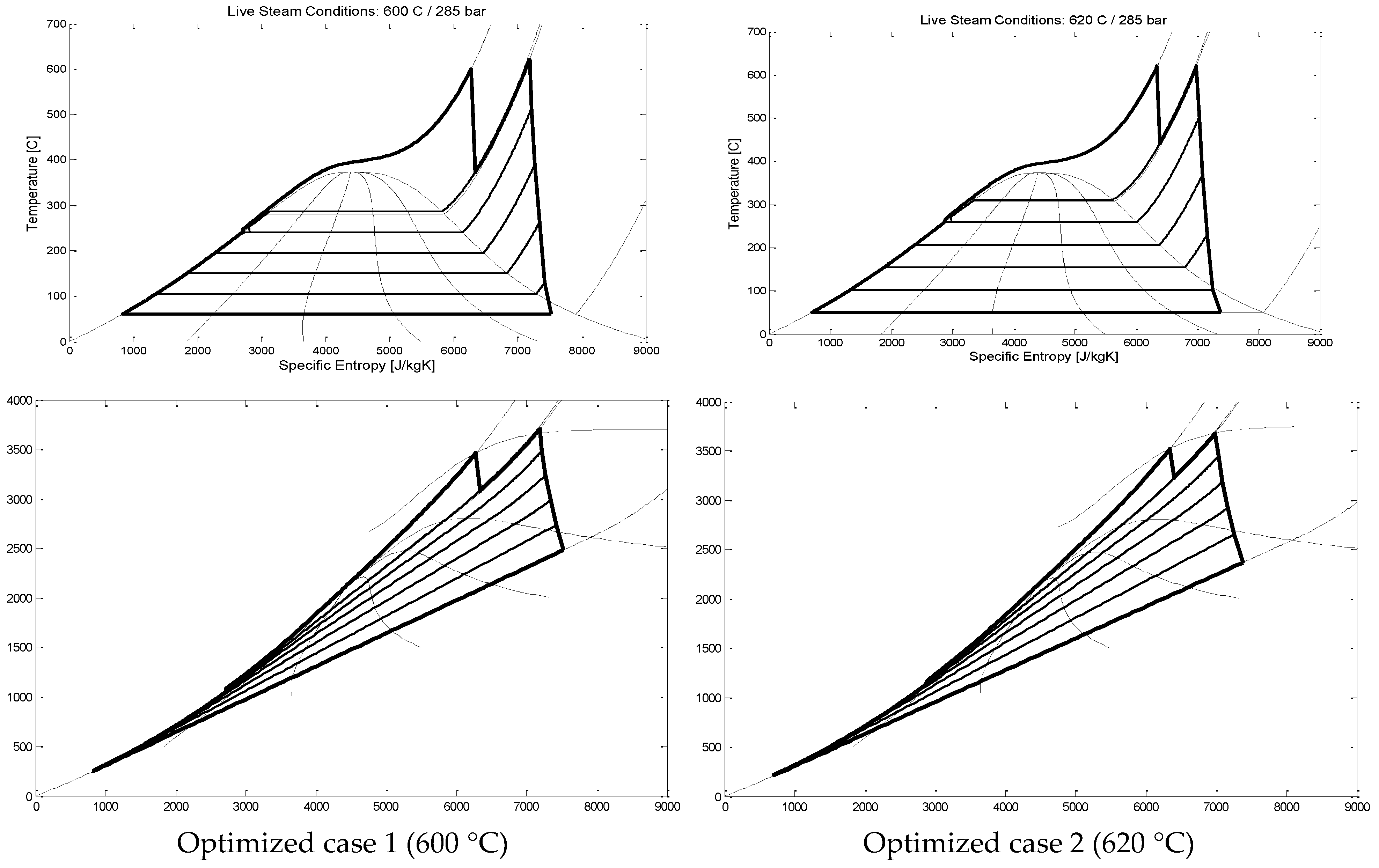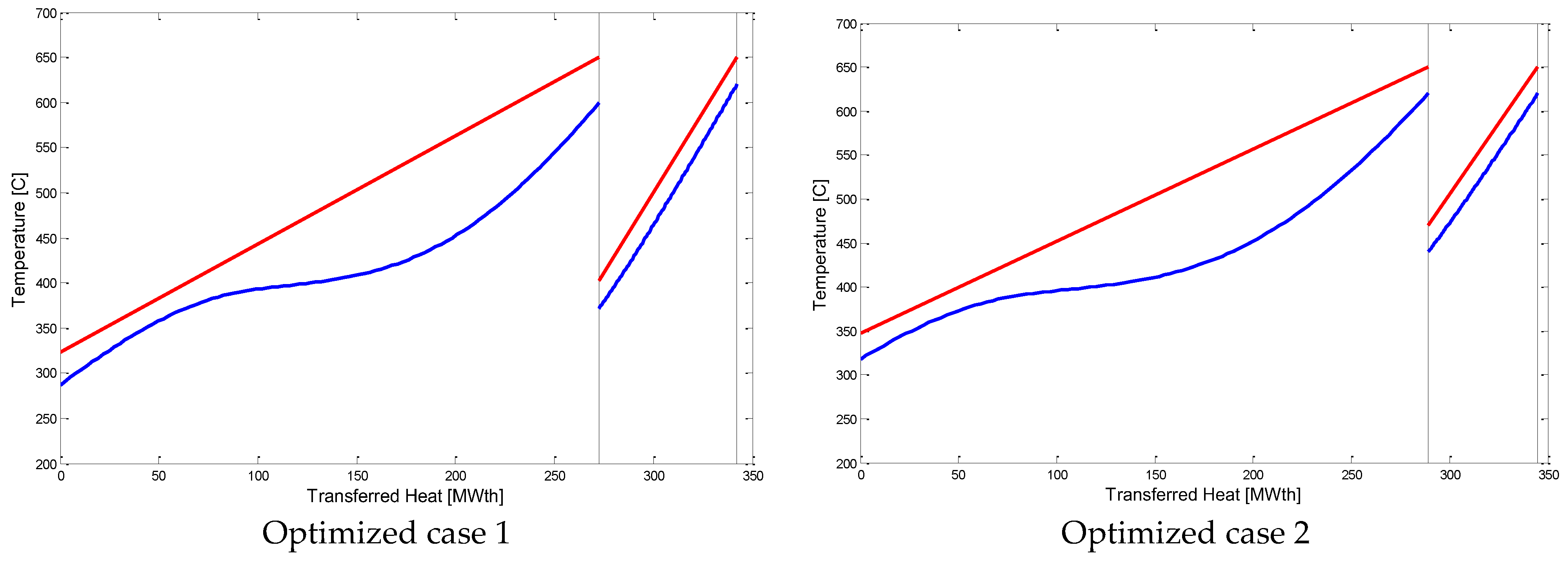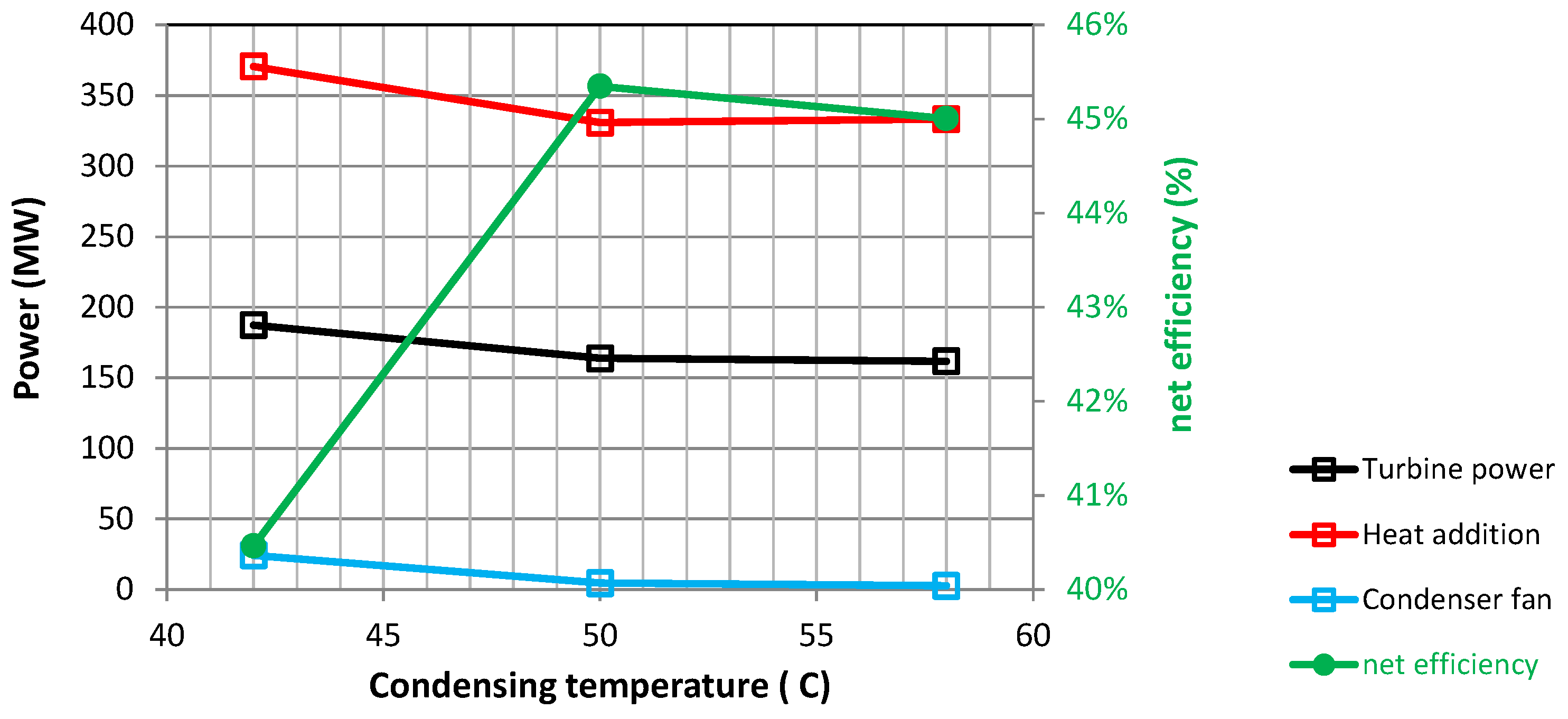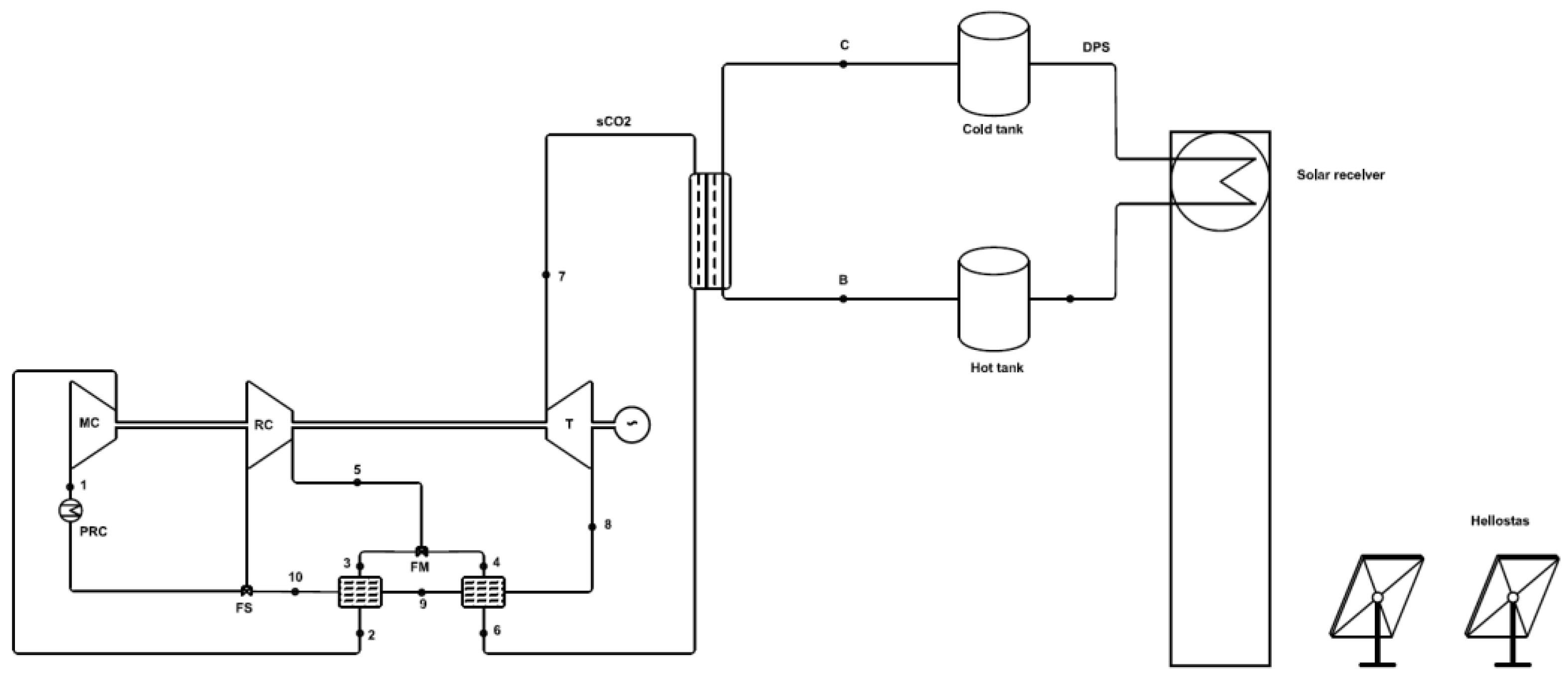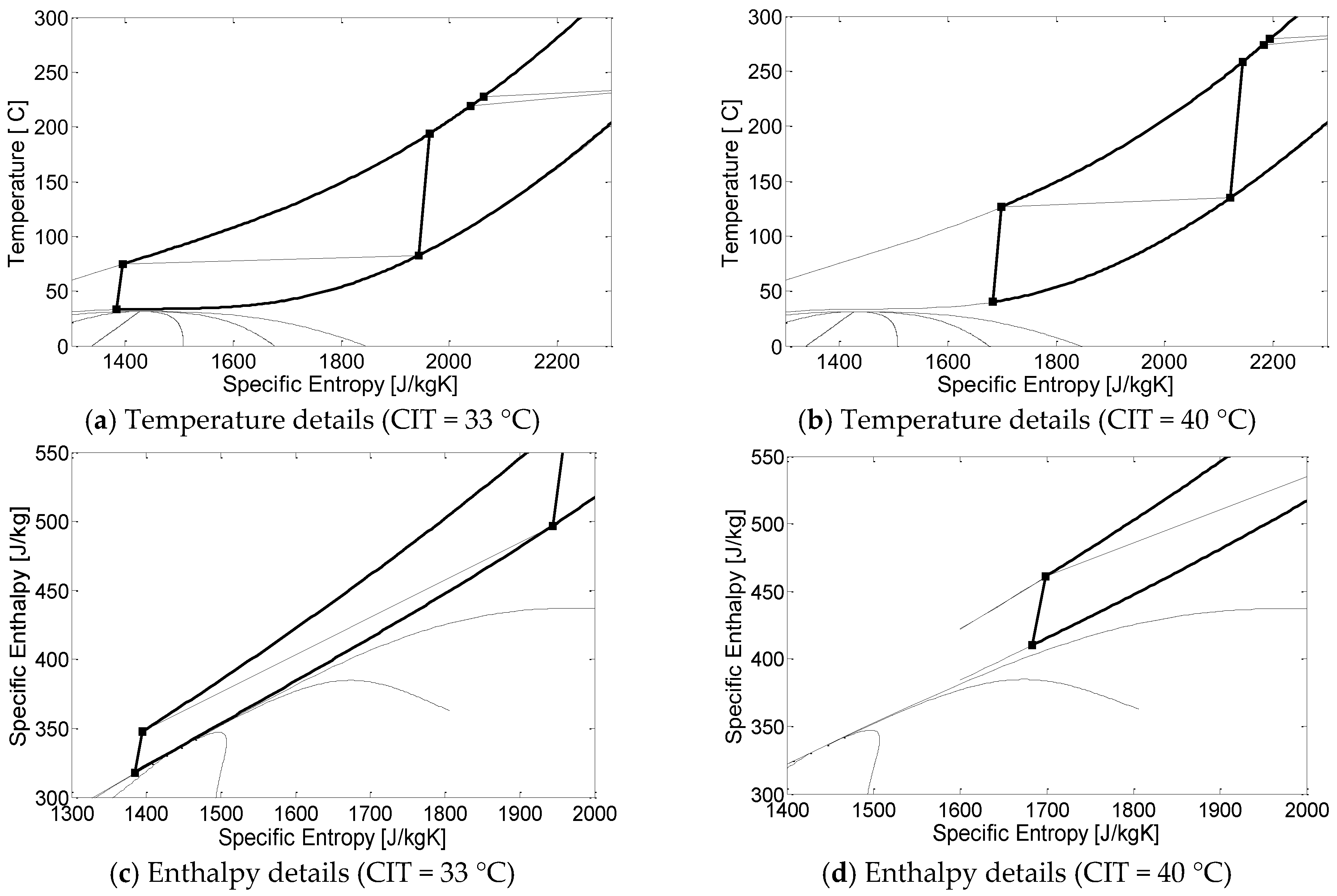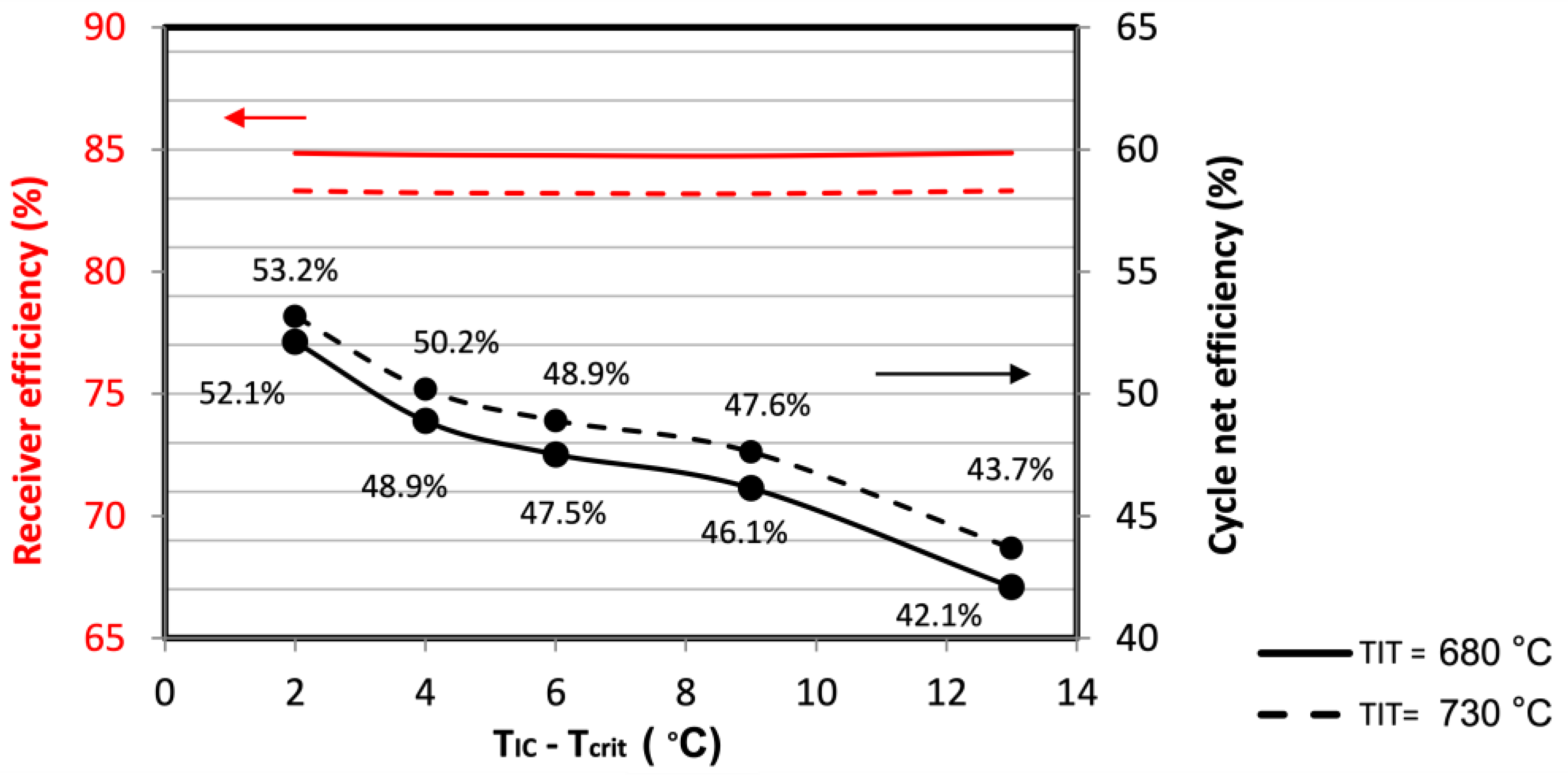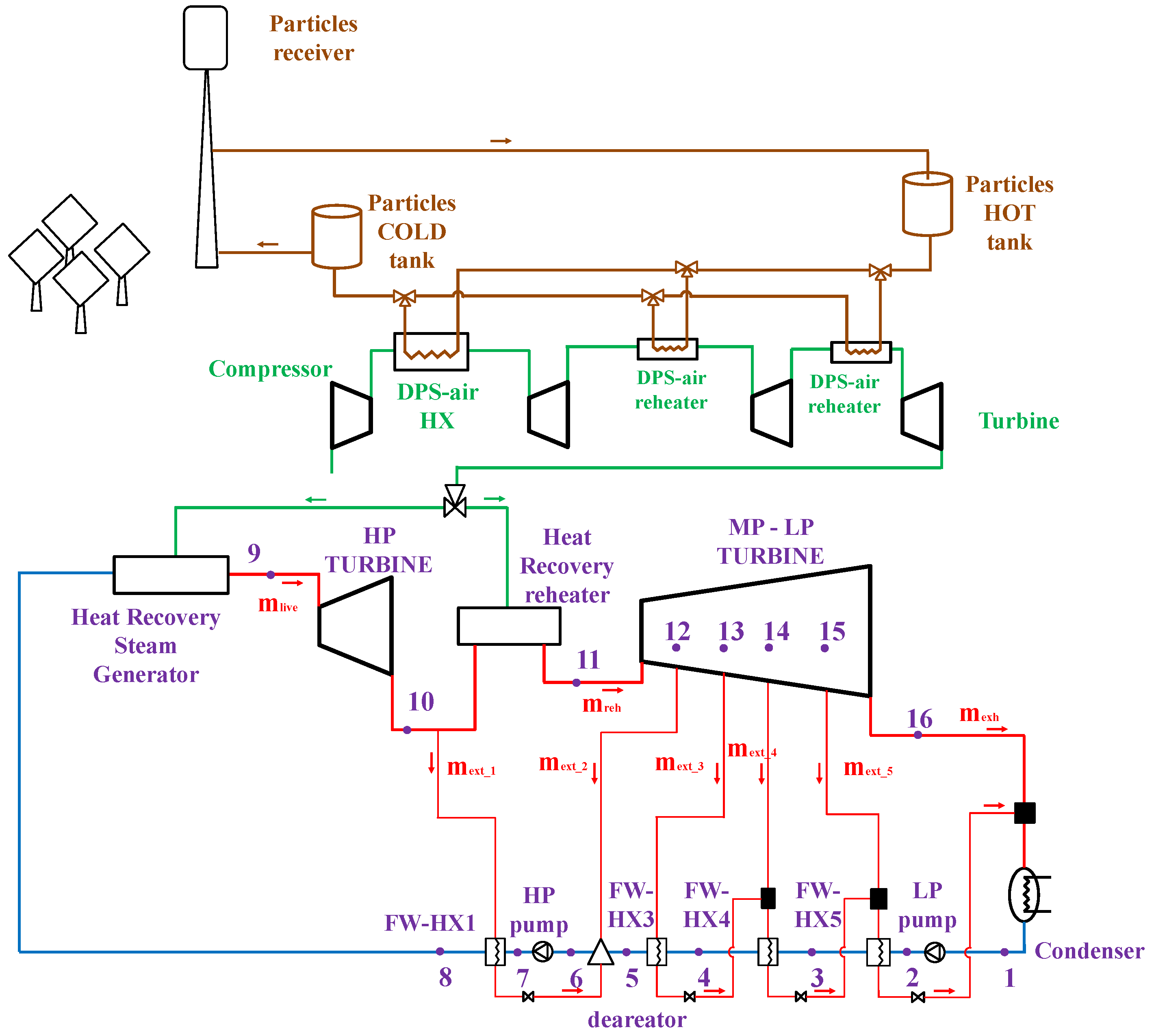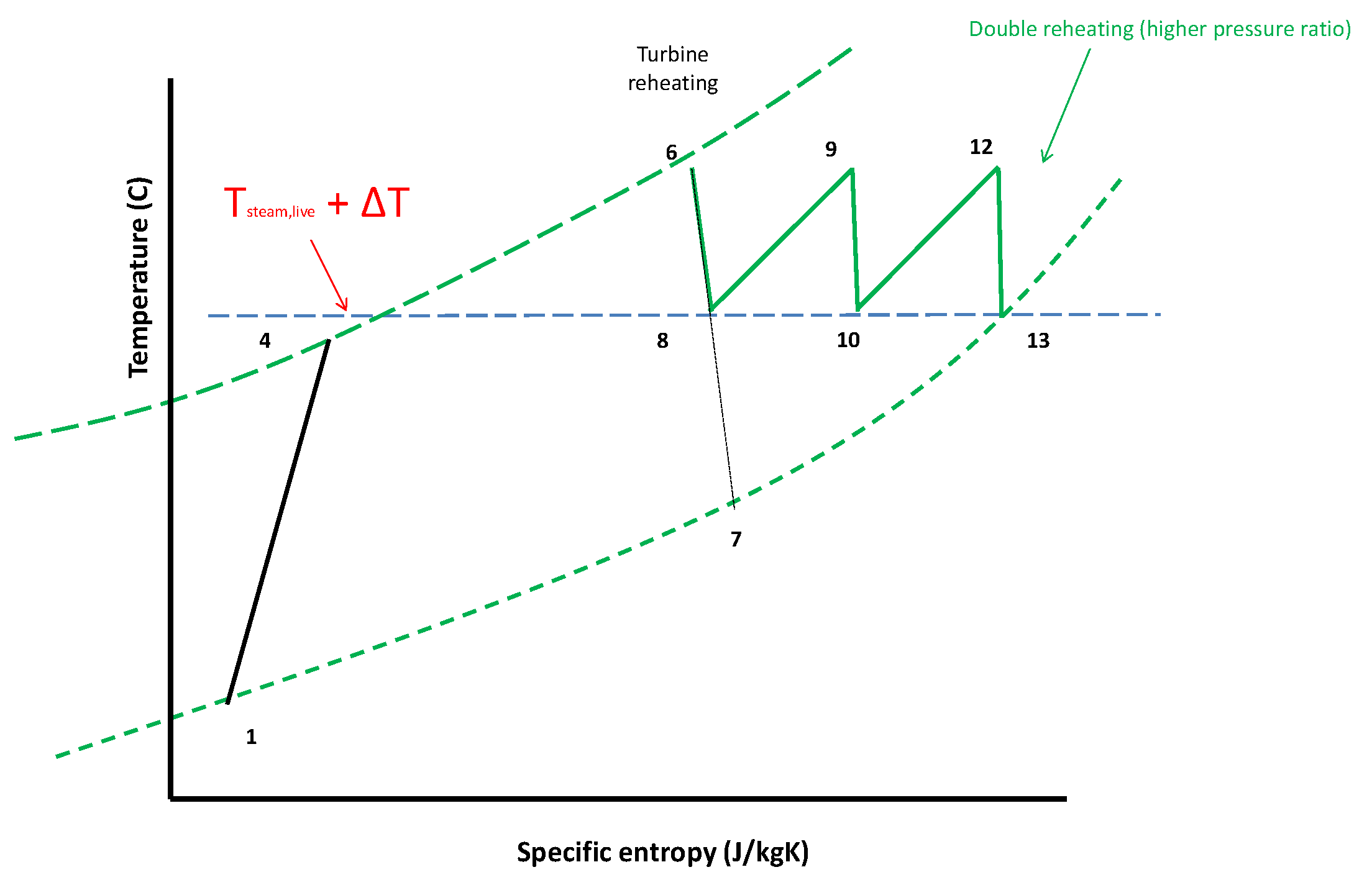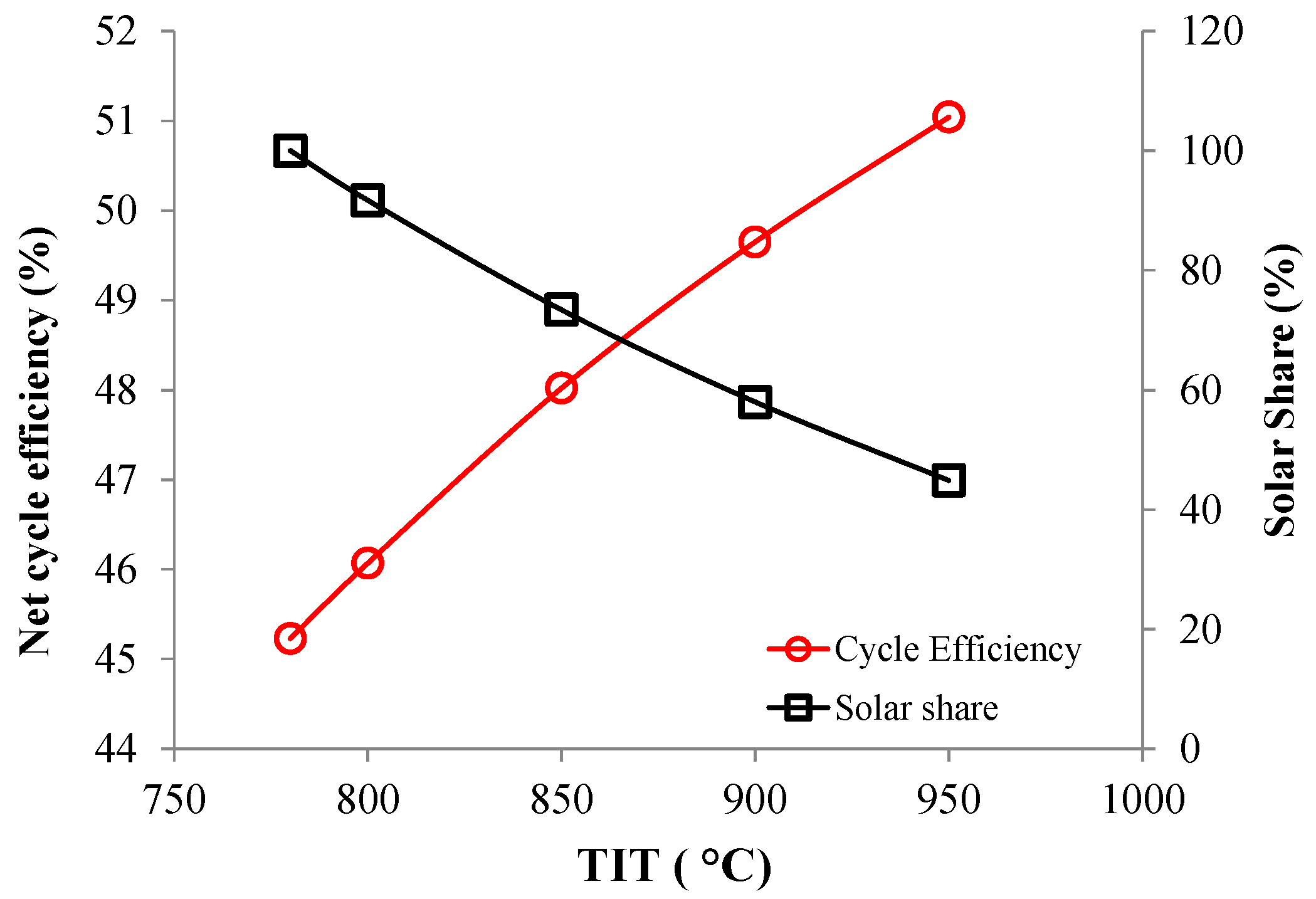The supercritical steam Rankine cycle, supercritical carbon dioxide cycle and integrated solar combined power cycle configurations and working conditions were optimized for coupling with the particle-based solar receiver.
3.1. Supercritical Rankine Cycle (S-Steam)
The critical conditions for a water stand at 220 bar and 374 °C with a turbine reheating plant layout were considered to maximize the power cycle efficiency. Typically, an optimal reheating pressure of around one-third of the superheated steam pressure is considered for reheated steam cycles [
31].
Table 2 summarizes the boundary conditions for modeling the supercritical steam Rankine cycle layout shown in
Figure 3 [
32], where five steam extractions were considered for feedwater chain preheating to reduce the heat added for steam generation.
Different working conditions of the pressure and temperature levels for superheated steam, reheated steam and the condenser were analyzed when seeking maximum power cycle efficiency. For the sake of simplicity, two optimized cases are summarized in
Table 3 that correspond to two different temperature levels at the condenser (60 °C and 50 °C). Reducing the steam condensing temperature from 60 °C to 50 °C translates into the higher power consumption of the dry-cooling fan, as can be observed in
Table 3 for optimized Case 2. This is due to the lower temperature difference between the cooling source (ambient air) and the condensing steam.
It is also true that reducing the steam condensing temperature allows for higher low-pressure turbine power extraction based on the higher enthalpy change of the exhaust steam. However, the steam quality significantly decreases from 95% to 90% at the last turbine stage. A minimum steam quality criterion of 90% is considered from a practical point of view to avoid excessive water droplet formation and consequent turbine blade erosion. Although it is desirable to keep the condenser pressure as low as possible, even if that means more moisture (and erosion), the increase in the parasitic losses of the dry-cooling fans will have excessive negative effects on the thermodynamic optimization of the power cycle, as is shown later in Figure 6.
In addition to a lower condensing temperature, optimized Case 2 is also fed by a higher superheated steam temperature (620 °C). In both simulated cases, a maximum pressure of 285 bar was considered, which is a reasonable value for state-of-the-art supercritical one-through steam generators [
33].
Figure 4 summarizes the detailed temperature and enthalpy evolution for both optimized cases;
Figure 4 (top) sketches the T-s diagram while
Figure 4 (bottom) shows the h-s diagram for superheated steam conditions of 600 °C (left) and 620 °C (right), respectively.
Figure 5 shows the detailed temperature evolution of the water-steam (blue line) and hot particles (red line) in the detailed heat exchanger network. As can be noticed, improved thermal performance can be achieved for the supercritical cycle scheme compared to similar subcritical cases [
25]. This is based on the higher average temperature of the added heat and the single phase transition for the supercritical state.
The average temperature is related to the heat input and the entropy gain; the higher the pressure, the higher the temperature of the plateau of the subcritical cycle (or the pseudo-plateau of a supercritical cycle). The second reason is as follows: the higher the pressure, the smaller the phase-change plateau, which is replaced by an s-shape profile when the cycle becomes supercritical (p > 221 bar). Consequently, the exergetic losses of the heat transfer between the primary fluids (combustion gas in a coal plant or particles in this case) are lower because the ΔT is lower.
Condensing Temperature Effect
Table 4 summarizes the power balance of the different power plant components for working conditions corresponding to optimized Case 2, where different condensing temperatures are considered. As can be observed, the lower the condensing temperature, the higher the power produced at the low-pressure turbine, as expected. However, the water inlet temperature at the steam generator is also lower, and for that, it requires higher added heat to reach the given superheated steam conditions (620 °C at 285 bar).
As can be observed in
Table 4 and
Figure 6, the electric power consumed by the condenser fan rapidly increases as a function of the temperature (from 50 °C to 42 °C), which reduces the power cycle efficiency considerably.
Summarizing, a net power cycle efficiency above 45% (as targeted in
Table 1) can be achieved by considering the supercritical steam Rankine cycle coupled to a solar particle receiver working at 650 °C. The optimized power cycle configuration is based on 620 °C and 285 bar steam in a single reheated cycle with a 50 °C condensing temperature. Despite the higher gross efficiency found in
Table 3 (close to 48%), the net cycle efficiency is limited to 45.35% due to the large parasitic losses introduced by the dry-condenser fan’s power consumption and the high condensing temperature (50 °C). Commercial supercritical Rankine cycles in coal-fired power plants exhibit slightly higher net efficiencies (above 46%) [
34] due to the wet-cooling system, which allows for lower condensing temperatures and lower parasitic power consumption.
3.2. Supercritical CO2 Cycle (S-CO2)
Figure 7 shows the plant layout of a recompression s-CO
2 power cycle coupled with a solar particle receiver. The recompression s-CO
2 plant layout was chosen due to its simplicity and reasonably good efficiency [
21,
35]. This cycle is highly recuperative and consists of a low-temperature (LTR) and high-temperature heat exchanger (HTR). The CO
2 mass split fraction that circulates through each compressor and recuperator is crucial for maximizing the power cycle efficiency [
36]. As several researchers have discussed, optimal results are found for a split fraction around 0.25, depending on the recuperator efficiency and pinch point temperature [
37]. This means that 25% of the total circulating mass flow is diverted to the recompression compressor (RC), while 75% of the mass flow is pumped by the main compressor (MC).
As has been stated by several researchers [
36], the s-CO
2 power cycle efficiency is very sensitive to the working conditions, especially to the lowest temperature of the cycle (main compressor inlet temperature). This sensitivity is based on the CO
2 density and sudden changes in specific heat near the critical point (74 bar and 31 °C). In fact, near the critical point, CO
2 behaves as a liquid, and therefore, very low specific work is needed for compression (the compressor behaves as a pump). Nevertheless, as the compressor inlet temperature slightly increases above the critical temperature, the power required for compression rapidly increases (as happens with standard air Brayton cycles), which, in turn, reduces the power cycle efficiency.
Despite the widespread research interest in this power cycle for electricity production, which is based on its promising cycle efficiency and very compact components, there are still many technical challenges to be solved for the commercial deployment of this cycle concept in the near future [
38]. The main limitations are related to the need for special materials and sealings due to the corrosive nature of the working fluid, the very high working pressures (from 70 bar up to 300 bar) and the need for ensuring a compressor inlet temperature close to the critical one, which can limit power plant operations in arid areas. However, the adoption of certain dopants in the HTF instead of pure CO
2 can increase the fluid’s critical temperature, allowing for a condensing cycle in a hot environment with an ambient temperature higher than 40 °C [
39].
The working condition limits gathered in
Table 5 were considered for power cycle simulations based on a thorough literature review [
40] due to the lack of real data on commercial applications for electricity generation.
Figure 8 shows the temperature and enthalpy evolution of the S-CO
2 cycle for a main compressor inlet temperature (CIT) of 40 °C and a turbine inlet temperature of 680 °C and the nomenclature used in
Figure 7.
Considering the impact of a low temperature (MC compressor inlet) and high temperature (turbine inlet) on s-CO2 cycle performance, a sensitivity analysis was conducted considering two temperature levels for both the main compressor inlet (33 °C and 44 °C) and the turbine inlet (680 °C and 730 °C).
As can be observed in
Table 6, there is an extreme impact on the power cycle efficiency as the compressor inlet temperature increases. As can be seen in
Figure 9, the closer the compressor inlet temperature (T
IC) to the critical temperature (T
crit), the higher the power cycle efficiency. When the compressor inlet temperature increases to 2 °C above the critical point, the estimated power cycle efficiency is 52%. However, as the compressor inlet temperature increases to 13 °C above the critical point, the net cycle efficiency is drastically reduced to 42%. Practically, increasing the compressor inlet temperature by 1 °C reduces the power cycle efficiency by 1%. In the same graph, the turbine inlet temperature effect can be observed, where solid lines refer to a 680 °C turbine inlet temperature (TIT), while dashed lines refer to a 730 °C TIT. It can be summarized that increasing TIT by 50 °C represents a 1% improvement in the net cycle efficiency.
The compressor inlet temperature effect can be observed in
Figure 10, where enthalpy lines converge near the critical temperature, and hence, the absorbed power of the main compressor is significantly reduced.
In
Figure 9 and
Figure 10, it can be observed that there is a real need for reducing the compressor inlet state to as close as possible to the critical point conditions. Therefore, a wet-cooling condenser seems to be the most efficient option for this power cycle, mainly when coupled with CSP.
As can be noticed in
Figure 11, the particle receiver efficiency is barely affected by the compressor inlet temperature. However, the efficiency of the power cycle is improved thanks to the temperature increase of 50 °C, which nevertheless causes an increase in thermal losses in the efficiency of the solar receiver. Therefore, it can be concluded that there is no significant improvement in the sun-to-electricity efficiency by increasing TIT up to 730 °C.
The s-CO2 power cycle showed promising theoretical results, gaining a net cycle efficiency of over 50% (as was targeted) for a moderate temperature level at the turbine inlet. Nevertheless, it should be kept in mind that lowering the compressor inlet temperature closer to the critical conditions will be crucial for meeting the high-efficiency expectation. The dry cooling solution for pure CO2 is not recommended due to the cycle sensitivity to the compressor inlet temperature.
3.3. Integrated Solar Combined Cycle (ISCC)
In this section, the optimization of the ISCC layout is addressed, aimed at maximizing the efficiency of the power block. Different working conditions for the topping and bottoming power cycles (working pressures, maximum temperatures, cycle arrangement, etc.) were investigated considering a nameplate power of 150 MW
e and a receiver outlet DPS temperature of 800 °C. The dry condenser configuration was considered for dry climate scenarios. The components’ efficiency and losses in
Table 7 were considered [
15].
Several modifications were applied to the ISCC plant layout presented in previous works [
15] in order to increase the net cycle efficiency. The optimized power cycle architecture is shown in
Figure 12, where the modifications consist of an uncooled and unfired double-reheated topping Brayton cycle and a two-pressure subcritical Rankine cycle without steam extraction for the bottoming cycle.
As can be observed in
Figure 13, the Brayton double-reheating cycle allows an increase in the added heat’s average temperature, which is beneficial for the power cycle efficiency according to the second law of thermodynamics. The double-reheating process also allows for increasing the pressure ratio of the Brayton cycle, which translates into a higher average temperature of the added heat and a higher temperature at the end of the compression process (point 4) and, hence, a significant reduction in external heat addition. Despite the higher power consumption in the compression process, an improvement in the net cycle efficiency is expected. Furthermore, double turbine reheating allows for increasing the power plant efficiency when TIT is limited, as happens in this case due to the metallurgical limit of the turbine blade material for uncooled vanes.
Table 8 lists the process and the description of the double-reheating topping Brayton cycle in
Figure 13.
Table 9 lists the ISCC working parameters for the reference case [
15] and the optimal solution. As can be observed, a net cycle efficiency of over 45% can be achieved with the double-reheating process in the turbine using only solar thermal energy from the particle receiver and a maximum TIT of 780 °C compared to the high temperature of 1100 °C.
To reduce exergy destruction in the solar plant, it was decided that particle heat addition would take place at the same temperature level. In other words, the temperatures of working points 4, 8 and 10 (from
Figure 13) should be very similar.
The higher the TIT of the topping cycle, the higher the net power cycle efficiency.
Figure 14 shows ISCC’s net efficiency for the double-reheating configuration of the topping cycle at higher TIT; in these cases, the use of a back-up gas burner is assumed to increase the temperature level. The working conditions for the bottoming Rankine cycle (of ISCC) are kept the same as shown for the optimized case in
Table 10. As can be noticed, the higher the TIT, the higher the ISCC efficiency. However, the solar contribution drastically decreases from 100% (pure solar mode) to below 50%, as can be observed in
Table 10.


